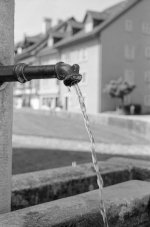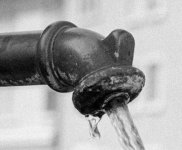sper
Well-known
So I recently picked up a Nikon Coolscan V, which I was very excited about considering I have only fond memories of my College's LS-9000, and had somewhat mixed feelings about the V700s performance with 35mm.
After working with the scanner for a few days I have to say that my thoughts remain unclear. I figured the Nikon would be far and above the better performer, but I have come to see that the differences are not night and day. I thought I share some very unscientific (therefore relevant to available light rangefinder photographers) comparisons and tests.
First off. The pictures were shot with an R2A and a Color Skopar 35mm f2.5, and the CV 21mm f4. The films are Tri-X, processed in Rodinal 1:50, Kodak E200 (chrome).
Lets look at two scans I from a Tri-X negative. I scanned the negative at 3200ppi in the V700, and at 4000 in the LS-50. I think 3200 is just about the 'sweet spot' with 35mm in the Epson.
This is one of my favorite shots. (Bessa-L & CV 21mm f4 @ f8 - Rodinal 1:50):


The image above shows the LS-50 file (on top) and the V700 file (in the Aperture window) The LS-50 image has higher pixel resolution, and sharper contrast, but I do not believe it shows actual resolution of detail that surpasses the detail resolved in the V700 scan. Coupled with the debris on the surface of the film that the LS-50 picks up, I would much rather deal with the V700 scan.

Here you see another detail from the lower left corner. Once again the LS-50 scan appears slightly sharper, but only just. This image would have to be printed at actual size for this difference to be picked up. And then I think, well hells bells, if I were making a print 18" wide, I would be far more satisfying renting darkroom space, or having a lab do a silver print.
This is the same image, and I further sharpened the V700 scan. I'll leave you free to make your own conclusions.

Color images are a bit of a different story. Please forgive the obnoxious water mark, but I'm trying to decide if I wanna buy Silverfast or not. Nikon Scan fails to see the scanner.

And a 100% crop:

In this case I think the LS-50 did a pretty great job. It's not super sharp, but hey, it's 35mm. Look at how far away I am! I have never ever been satisfied with 35mm chrome scans from the Epson. It lacks the dynamic range to pick up any highlight detail, which makes the images kind of 'glow' but in a real ugly way.
Here is a raw V700 scan:

Whoa lets give that some Lasik!

A little better, but it still doesn't match the contrast and color depth that came straight outta the LS-50.
So I gotta say, it's kind of a toss up. For color and certainly chrome I'm sold. But I also love shooting Tri-X...so in this case I don't know what to do. I'll probably start with a LS-50 scan, and see what I can get. If it's at all giving me problems I switch back to the Epson, knowing that I can get results pretty damn close to what the Nikon can deliver.
I wanted to show these samples because I thought people on this site gave the Nikon scanner a little too much credit. If I had to only own ONE scanner, it would be the Epson. it does a close enough job to the Nikon scanner to outweigh the major advantages. And with the Nikon's aging software and lack of support, the Epson really makes more sense.
Oh and if you haven't seen medium and large format scans, well you should. So I'm going to show them to you!
This is an 8x10 Ilford FP4+ negative scanned with the v700:

This is a 100% crop:
http://farm2.static.flickr.com/1419/1474914824_e58da1b1e0_o.jpg
This is a 4x5 Ilford Ortho+ negative:

100%:

Hasselblad color negative:

100%:

Hasselblad Tri-X negative:

100%:

That's right! There I am in her eyeball taking this picture. 🙂
So I'm not trying to make any major conclusions about either scanner here. I just thought I'd share some examples for people who may be wondering which one to purchase, or what it's like working with either device. Scanning is a critical skill, and I'm no pro, but I think I do okay.
If others have scan examples to show, particularly from the LS-9000 I would love to see them. Or examples with 35mm film and better (leica or Zeiss) lenses. I just wanted to get a discussion going that shows examples of what I'm seeing with the actual equipment from actual pictures I made in the real world.
After working with the scanner for a few days I have to say that my thoughts remain unclear. I figured the Nikon would be far and above the better performer, but I have come to see that the differences are not night and day. I thought I share some very unscientific (therefore relevant to available light rangefinder photographers) comparisons and tests.
First off. The pictures were shot with an R2A and a Color Skopar 35mm f2.5, and the CV 21mm f4. The films are Tri-X, processed in Rodinal 1:50, Kodak E200 (chrome).
Lets look at two scans I from a Tri-X negative. I scanned the negative at 3200ppi in the V700, and at 4000 in the LS-50. I think 3200 is just about the 'sweet spot' with 35mm in the Epson.
This is one of my favorite shots. (Bessa-L & CV 21mm f4 @ f8 - Rodinal 1:50):


The image above shows the LS-50 file (on top) and the V700 file (in the Aperture window) The LS-50 image has higher pixel resolution, and sharper contrast, but I do not believe it shows actual resolution of detail that surpasses the detail resolved in the V700 scan. Coupled with the debris on the surface of the film that the LS-50 picks up, I would much rather deal with the V700 scan.

Here you see another detail from the lower left corner. Once again the LS-50 scan appears slightly sharper, but only just. This image would have to be printed at actual size for this difference to be picked up. And then I think, well hells bells, if I were making a print 18" wide, I would be far more satisfying renting darkroom space, or having a lab do a silver print.
This is the same image, and I further sharpened the V700 scan. I'll leave you free to make your own conclusions.

Color images are a bit of a different story. Please forgive the obnoxious water mark, but I'm trying to decide if I wanna buy Silverfast or not. Nikon Scan fails to see the scanner.

And a 100% crop:

In this case I think the LS-50 did a pretty great job. It's not super sharp, but hey, it's 35mm. Look at how far away I am! I have never ever been satisfied with 35mm chrome scans from the Epson. It lacks the dynamic range to pick up any highlight detail, which makes the images kind of 'glow' but in a real ugly way.
Here is a raw V700 scan:

Whoa lets give that some Lasik!

A little better, but it still doesn't match the contrast and color depth that came straight outta the LS-50.
So I gotta say, it's kind of a toss up. For color and certainly chrome I'm sold. But I also love shooting Tri-X...so in this case I don't know what to do. I'll probably start with a LS-50 scan, and see what I can get. If it's at all giving me problems I switch back to the Epson, knowing that I can get results pretty damn close to what the Nikon can deliver.
I wanted to show these samples because I thought people on this site gave the Nikon scanner a little too much credit. If I had to only own ONE scanner, it would be the Epson. it does a close enough job to the Nikon scanner to outweigh the major advantages. And with the Nikon's aging software and lack of support, the Epson really makes more sense.
Oh and if you haven't seen medium and large format scans, well you should. So I'm going to show them to you!
This is an 8x10 Ilford FP4+ negative scanned with the v700:

This is a 100% crop:
http://farm2.static.flickr.com/1419/1474914824_e58da1b1e0_o.jpg
This is a 4x5 Ilford Ortho+ negative:

100%:

Hasselblad color negative:

100%:

Hasselblad Tri-X negative:

100%:

That's right! There I am in her eyeball taking this picture. 🙂
So I'm not trying to make any major conclusions about either scanner here. I just thought I'd share some examples for people who may be wondering which one to purchase, or what it's like working with either device. Scanning is a critical skill, and I'm no pro, but I think I do okay.
If others have scan examples to show, particularly from the LS-9000 I would love to see them. Or examples with 35mm film and better (leica or Zeiss) lenses. I just wanted to get a discussion going that shows examples of what I'm seeing with the actual equipment from actual pictures I made in the real world.
Last edited:











